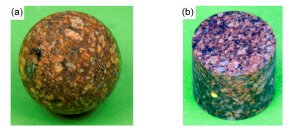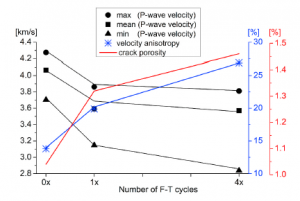Rapakivi in Finnish means «rotten stone». These very beautiful granites, widely used in construction as facing material, are often represented in nature by granular-block-destroyed massifs, and often destruction is observed only in the near-surface region. Over time, architectural structures made from rapakivi also tend to crack and collapse. Among other things, there is the problem of preventing the destruction of the unique Alexandria Pillar on the Palace Square in St. Petersburg. Failure of rapakivi granites is usually interpreted as fatigue failure, generated, for example, by cyclic changes in internal stresses during heating and cooling of rocks and during their freezing and thawing.

The work investigated the initial stage of such destruction, when microcracks develop in visually integral samples of rapakivi granites, the anisotropy of the structure and the values of porosity and permeability grow. Rapakivi samples (Fig. 1) were examined by an international team of specialists from Dubna, Moscow and Prague. Experiments included neutron spectroscopy, 3D ultrasound, and measurements of the permeability and porosity of samples at different pressures. The experiments also provided for cyclic freezing, heating of water-saturated and dry samples and carrying out measurements under conditions of elevated pressures.

As a result of the experiments, it was shown that during the first and repeated cycles of freezing and heating of samples, predominantly oriented microfracturing develops in them. Fig. 2 shows how the elastic velocities in the sample decrease and the porosity and elastic anisotropy increase during repeated freeze-heating cycles. By analogy with the results of studies of fatigue fracture, it can be assumed that the fracture of the sample will grow approximately in proportion to the logarithm of the number of growth-decrease cycles of internal stresses.
The initial sample was taken by M.V. Rodkin during field macroseismic studies in Karelia.
Note that similar processes of development of granular-block destruction are characteristic not only of rapakivi granites, but also of many other types of rocks. And this process has important applications not only in terms of the destruction of rocks, but also in the geology of oil and gas. Itis known, that in connection with the depletion of shallow hydrocarbon deposits of the usual type, more and more attention is paid to the search for hydrocarbon deposits in the crystalline basement. And such deposits are often formed in highly destroyed brecciated granites, such is, for example, the White Tiger oil deposit, unique in reserves, located on the shelf of Vietnam. Hence, problems arise as to describe the mechanisms of granite brecciations at significant depths of the Earth’s crust and to identify such massifs that are potential reservoirs for oil and gas.
Ivankina T.I., Zel I.Y., Petruzalek M., Rodkin M.V., Matveev M.A., Lokajicek T. Elastic anisotropy, permeability, and freeze-thaw cycling of rapakivi granite // International Journal of Rock Mechanics and Mining Sciences. 2020. V. 136. Article 104541. DOI:10.1016/j.ijrmms.2020.104541.
